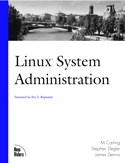

Although it addresses some of the how-to's, it is more of a “why-to”.

Authors: M. Carling, Stephen Degler, James T. Dennis
Publisher: New Riders Publishing
Price: $29.99 US
ISBN: 0-56205-934-3
Reviewer: Paul Almquist
Linux System Administration is not the average “how-to” for the system administrator. Although it addresses some of the how-to's, it is more of a “why-to”. The book is divided into 3 parts: Principles, Practicum and Services. Throughout, administration principles are emphasized, followed by practical suggestions.
Part I, Principles (chapters 1-7), starts out with a discussion of “The Prime Directive: to provide and maintain access to system resources.” In other words, why we are doing this job; not just because it's fun, although it should be most of the time. It goes back to the basic reason for the existence of computers—to provide a service to the users. “Requirements Analysis” is then examined to put some legs on the prime directive.
If you are responsible for your own Linux box at home or at work, you might let “Recovery Planning” slip, but when you are supporting the work of others in the enterprise, a recovery plan is essential. Computers will fail. Users will make mistakes. How will you respond? The authors present the interesting concept of a rescue partition and an auto-rescue configuration to automate recovery from some disasters, although they missed the opportunity to identify just what constitutes “a full suite of repair tools”. The experienced system administrator will know some, but the beginners need more guidance. Numerous recovery issues are discussed, including administrator error.
Too often we get caught up in a putting-out-files mode. The chapter on capacity planning gives guidance in preventing fires. Principles ends with a discussion of the Help Desk, Network Computing and Security Policy.
Part II, Practicum (chapters 8-16), begins with the topic of enforcing security. Certainly not an exhaustive treatment, considering another recently published book has several hundred pages on just this one subject, but fundamental topics are addressed. Exploits and their consequences should have you thinking of your recovery planning again. This chapter and most of the following chapters end with a reading list citing relevant HOW-TOs and many other books. Booting and shutdown reviews LILO, MILO and SILO and the System V startup/shutdown rc scripts. If you need to build a custom kernel, the chapter entitled “Configuring and Building Kernels” gives some helpful hints. Everyone finds some tasks repetitive. The chapter on scripting offers ideas in several scripting languages.
There are two kinds of computer users: those who do backup, and those who will. The Backup chapter discusses practical solutions to the problem. Most computers are on a network today. Networking Technologies discusses IPv4, IPv6 and related protocols. This chapter has an extensive reading list.
Do you have several systems to support? Wish they all had the same configuration? System Profiles gives good guidance here. This chapter has the best discussion of disk partitioning theory I have read—not just a set of recommended sizes, but why various branches ought to be separated into their own partitions. Once you have a partitioning plan, the OS has to be installed on all machines and upgraded as necessary. Automated Installation and Upgrade discusses some how-to guidelines, including Red Hat's kickstart. User and Group Administration appropriately follows.
Part III, Services (chapters 17-21), has 40 pages reviewing network services, mail, printing and faxing, working with NFS and managing NIS. Little nuggets of information are sprinkled throughout.
Appendix A is something we hope we never need, but know we must deal with: emergencies. It starts with the lost root password and ends with some miscellaneous performance problems. Appendix A is followed by a glossary, worth reading in that it's more of a mini-encyclopedia than a dictionary. The index is huge for a book this size (41 pages long), making it a valuable tool for using this book as a reference.
Eric S. Raymond, writer of the book's Forward, says in a review on its back cover, “This book is a reference for the experienced Linux administrators and a guide for new ones.” I heartily agree and recommend a thorough reading.